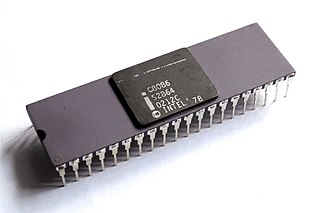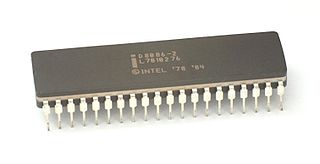
The Intel 8080 ("eighty-eighty") is the second 8-bit microprocessor designed and manufactured by Intel. It first appeared in April 1974 and is an extended and enhanced variant of the earlier 8008 design, although without binary compatibility. Although earlier microprocessors were commonly used in mass-produced devices such as calculators, cash registers, computer terminals, industrial robots, and other applications, the 8080 saw greater success in a wider set of applications, and is largely credited with starting the microcomputer industry.

The 8086 is a 16-bit microprocessor chip designed by Intel between early 1976 and June 8, 1978, when it was released. The Intel 8088, released July 1, 1979, is a slightly modified chip with an external 8-bit data bus, and is notable as the processor used in the original IBM PC design.

x86 is a family of complex instruction set computer (CISC) instruction set architectures initially developed by Intel, based on the 8086 microprocessor and its 8-bit-external-bus variant, the 8088. The 8086 was introduced in 1978 as a fully 16-bit extension of 8-bit Intel's 8080 microprocessor, with memory segmentation as a solution for addressing more memory than can be covered by a plain 16-bit address. The term "x86" came into being because the names of several successors to Intel's 8086 processor end in "86", including the 80186, 80286, 80386 and 80486. Colloquially, their names were "186", "286", "386" and "486".

The Intel 8085 ("eighty-eighty-five") is an 8-bit microprocessor produced by Intel and introduced in March 1976. It is the last 8-bit microprocessor developed by Intel.
The Intel x86 computer instruction set architecture has supported memory segmentation since the original Intel 8086 in 1978. It allows programs to address more than 64 KB (65,536 bytes) of memory, the limit in earlier 80xx processors. In 1982, the Intel 80286 added support for virtual memory and memory protection; the original mode was renamed real mode, and the new version was named protected mode. The x86-64 architecture, introduced in 2003, has largely dropped support for segmentation in 64-bit mode.
x86 assembly language is a family of low-level programming languages that are used to produce object code for the x86 class of processors. These languages provide backward compatibility with CPUs dating back to the Intel 8008 microprocessor, introduced in April 1972. As assembly languages, they are closely tied to the architecture's machine code instructions, allowing for precise control over hardware.
Architectural state is the collection of information in a computer system that defines the state of a program during execution. Architectural state includes main memory, architectural registers, and the program counter. Architectural state is defined by the instruction set architecture and can be manipulated by the programmer using instructions. A core dump is a file recording the architectural state of a computer program at some point in time, such as when it has crashed.
Fetching the instruction opcodes from program memory well in advance is known as prefetching and it is served by using a prefetch input queue (PIQ). The pre-fetched instructions are stored in a queue. The fetching of opcodes well in advance, prior to their need for execution, increases the overall efficiency of the processor boosting its speed. The processor no longer has to wait for the memory access operations for the subsequent instruction opcode to complete. This architecture was prominently used in the Intel 8086 microprocessor.

A general protection fault (GPF) in the x86 instruction set architectures (ISAs) is a fault initiated by ISA-defined protection mechanisms in response to an access violation caused by some running code, either in the kernel or a user program. The mechanism is first described in Intel manuals and datasheets for the Intel 80286 CPU, which was introduced in 1983; it is also described in section 9.8.13 in the Intel 80386 programmer's reference manual from 1986. A general protection fault is implemented as an interrupt. Some operating systems may also classify some exceptions not related to access violations, such as illegal opcode exceptions, as general protection faults, even though they have nothing to do with memory protection. If a CPU detects a protection violation, it stops executing the code and sends a GPF interrupt. In most cases, the operating system removes the failing process from the execution queue, signals the user, and continues executing other processes. If, however, the operating system fails to catch the general protection fault, i.e. another protection violation occurs before the operating system returns from the previous GPF interrupt, the CPU signals a double fault, stopping the operating system. If yet another failure occurs, the CPU is unable to recover; since 80286, the CPU enters a special halt state called "Shutdown", which can only be exited through a hardware reset. The IBM PC AT, the first PC-compatible system to contain an 80286, has hardware that detects the Shutdown state and automatically resets the CPU when it occurs. All descendants of the PC AT do the same, so in a PC, a triple fault causes an immediate system reset.
The x86 instruction set refers to the set of instructions that x86-compatible microprocessors support. The instructions are usually part of an executable program, often stored as a computer file and executed on the processor.
The Program Segment Prefix (PSP) is a data structure used in DOS systems to store the state of a program. It resembles the Zero Page in the CP/M operating system. The PSP has the following structure:
INT 13h is shorthand for BIOS interrupt call 13hex, the 20th interrupt vector in an x86-based computer system. The BIOS typically sets up a real mode interrupt handler at this vector that provides sector-based hard disk and floppy disk read and write services using cylinder-head-sector (CHS) addressing. Modern PC BIOSes also include INT 13h extension functions, originated by IBM and Microsoft in 1992, that provide those same disk access services using 64-bit LBA addressing; with minor additions, these were quasi-standardized by Phoenix Technologies and others as the EDD BIOS extensions.
In computing, the x86 memory models are a set of six different memory models of the x86 CPU operating in real mode which control how the segment registers are used and the default size of pointers.
A Trace Vector Decoder (TVD) is computer software that uses the trace facility of its underlying microprocessor to decode encrypted instruction opcodes just-in-time prior to execution and possibly re-encode them afterwards. It can be used to hinder reverse engineering when attempting to prevent software cracking as part of an overall copy protection strategy.
The FLAGS register is the status register that contains the current state of an x86 CPU. The size and meanings of the flag bits are architecture dependent. It usually reflects the result of arithmetic operations as well as information about restrictions placed on the CPU operation at the current time. Some of those restrictions may include preventing some interrupts from triggering, prohibition of execution of a class of "privileged" instructions. Additional status flags may bypass memory mapping and define what action the CPU should take on arithmetic overflow.
This article describes the calling conventions used when programming x86 architecture microprocessors.
The 65xx family of microprocessors, consisting of the MOS Technology 6502 and its derivatives, the WDC 65C02, WDC 65C802 and WDC 65C816, and CSG 65CE02, all handle interrupts in a similar fashion. There are three hardware interrupt signals common to all 65xx processors and one software interrupt, the BRK instruction. The WDC 65C816 adds a fourth hardware interrupt—ABORT, useful for implementing virtual memory architectures—and the COP software interrupt instruction, intended for use in a system with a coprocessor of some type.
A stack register is a computer central processor register whose purpose is to keep track of a call stack. On an accumulator-based architecture machine, this may be a dedicated register. On a machine with multiple general-purpose registers, it may be a register that is reserved by convention, such as on the IBM System/360 through z/Architecture architecture and RISC architectures, or it may be a register that procedure call and return instructions are hardwired to use, such as on the PDP-11, VAX, and Intel x86 architectures. Some designs such as the Data General Eclipse had no dedicated register, but used a reserved hardware memory address for this function.

C# Open Source Managed Operating System (Cosmos) is a toolkit for building GUI and command-line based operating systems, written mostly in the programming language C# and small amounts of a high-level assembly language named X#. Cosmos is a backronym, in that the acronym was chosen before the meaning. It is open-source software released under a BSD license.

GNUSim8085 is a graphical simulator, assembler and debugger for the Intel 8085 microprocessor in Linux and Windows. It is among the 20 winners of the FOSS India Awards announced in February 2008. GNUSim8085 was originally written by Sridhar Ratnakumar in fall 2003 when he realized that no proper simulators existed for Linux. Several patches, bug fixes and software packaging have been contributed by the GNUSim8085 community. GNUSim8085 users are encouraged to contribute to the simulator through coding, documenting, testing, translating and porting the simulator.






